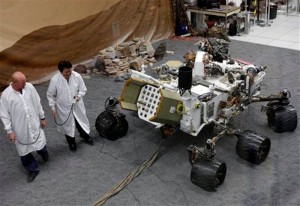Mars rover to launch first rock study

Engineers work on a model of the Mars rover Curiosity at the Spacecraft Assembly Facility at NASA’s Jet Propulsion Laboratory in Pasadena, California, Thursday, Aug. 2, 2012. AP PHOTO/DAMIAN DOVARGANES
WASHINGTON — NASA’s Curiosity Rover will study its first martial rock Friday, more than a month after landing on the Red Planet, mission officials said.
Mars Science Laboratory project scientist John Grotzinger said the rover drove for another 100 feet (30 meters) last night, for a total travel distance of 950 feet so far.
“So we are making steady progress toward Glenelg,” a region where three different terrains join together, he told a teleconference. “We are actually half way there.”
Curiosity is on a two-year mission to investigate whether it is possible to live on Mars and to learn whether conditions there might have been able to support life in the past.
The science team plans to have Curiosity pause for a few days in order to perform the mission’s first “contact science” by using instruments on the vehicle’s robot arm to photograph and analyze a pyramid-shaped rock.
Article continues after this advertisementThe rock measures about 10 inches (25 centimeters) high by 16 inches wide at the base.
Article continues after this advertisementIt will be photographed by the rover’s Mars Hand Lens Imager, or MAHLI, and its Alpha Particle X-ray Spectrometer, or APXS, which can assess the rock’s chemical composition. Curiosity, equipped with a total of 10 scientific instruments, also has a powerful laser that can reach targets up to 23 feet away.
In recent days, the rover has snapped hundreds of photographs of three partial eclipses of the sun by the two Martian moons Phobos and Deimos.
Curiosity’s final destination is the base of Mount Sharp, a mound of layered terrain at the heart of Gale Crater that could reveal clues about the geological history of Mars. The journey is expected to take at least three months.